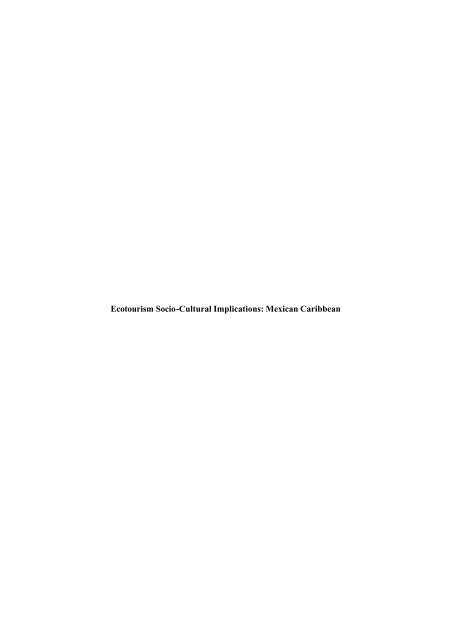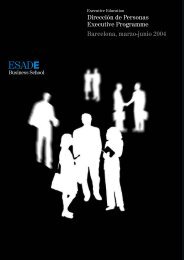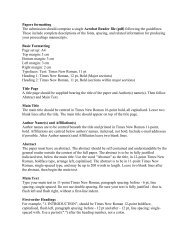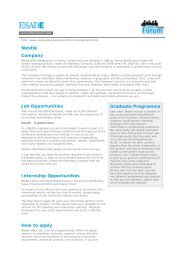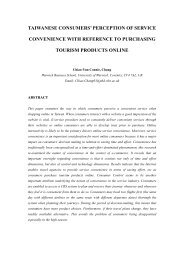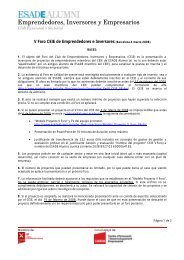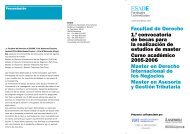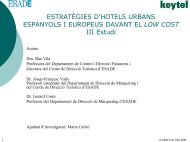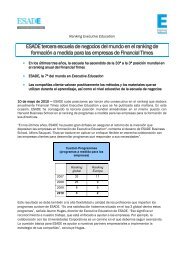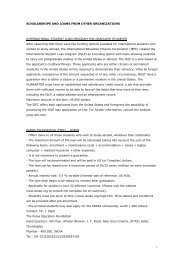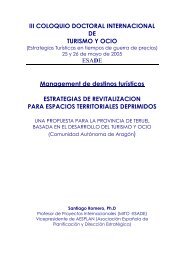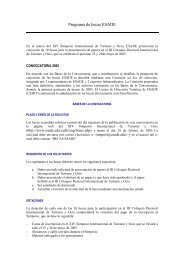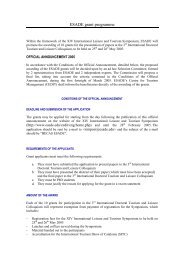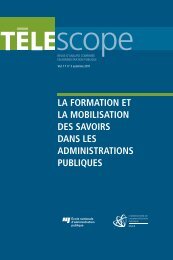Carballo-Sandoval and Cuevas-Contreras 1 07 - Esade
Carballo-Sandoval and Cuevas-Contreras 1 07 - Esade
Carballo-Sandoval and Cuevas-Contreras 1 07 - Esade
Create successful ePaper yourself
Turn your PDF publications into a flip-book with our unique Google optimized e-Paper software.
Ecotourism Socio-Cultural Implications: Mexican Caribbean
Ecotourism Socio-Cultural Implications: Mexican Caribbean<br />
Arturo <strong>Carballo</strong>-<strong>S<strong>and</strong>oval</strong> 1<br />
Assistant Professor<br />
Economic Sciences Department<br />
Instituto Tecnológico de Cancún (ITC), México<br />
Ticimul # 74 Mz 12 L5 Super Manzana 59<br />
Cancún, Quintana Roo, México CP 77515<br />
Office Phone: (998) 880 - 7432<br />
Home Phone: (998) 886 - 5808<br />
Fax: (998) 880-7433<br />
E-mail: acarballo@itcancun.edu.mx<br />
Tomás <strong>Cuevas</strong>-<strong>Contreras</strong> 2<br />
Assistant Professor<br />
Tourism Faculty<br />
Universidad Autónoma de Ciudad Juárez (UACJ), México<br />
Valentín Fuentes # 2015 Fracc. El Portal<br />
Ciudad Juárez, Chihuahua, México CP 32370<br />
Office Phone: (656) 688 –3800 Ext. 3683<br />
Home Phone: (656) 618 – 2482<br />
Fax: (656) 623 - 6376<br />
E-mail: tcuevas@uacj.mx<br />
1 Assistant Professor of sustainable tourism His main research interests are the tourism<br />
sustainability <strong>and</strong> alternative tourism, currently involved in ecotourism community-based<br />
projects in the Mayan zone (Quintana Roo <strong>and</strong> Yucatán, México). Arturo is active in the<br />
Business <strong>and</strong> Economic Academy. He has published widely numerous articles. Arturo holds a<br />
Ph. D. in Human Geography from the University of Reading at the United Kingdom.<br />
acarballo@itcancun.edu.mx.<br />
2 Assistant Professor <strong>and</strong> member of the tourism faculty of UACJ, México. He teaches<br />
environmental tourism <strong>and</strong> management tourism. His research interests include U.S.-México<br />
border issues nd ecotourism development in México. He holds a BA in Tourism from Instituto<br />
Politécnico Nacional, Mexico, <strong>and</strong> MBA from Universidad Autónoma de Ciudad Juárez,<br />
México, <strong>and</strong> Ph. D. C<strong>and</strong>idate in Business Administration from the Universidad Nacional<br />
Autónoma de México.<br />
1
Ecotourism Socio-Cultural Implications: Mexican Caribbean<br />
Abstract<br />
This paper is a view of the Maya culture related to ecotourism. Unity in ethnic Mayan is an<br />
important issue. Generally Mayan families are large, usually eight members. This was evidenced<br />
in the questionnaire administered to locals in San Juan, Punta Allen <strong>and</strong> Xcalak. The survey was<br />
designed with the purpose of underst<strong>and</strong>ing ‘Mayan Culture’, <strong>and</strong> determining the influence of<br />
tourist in the lives of the locals; the evidence was not conclusive. The perception within the<br />
communities was that there was little or no change.<br />
In conclusion, the success of the Mayan community-based ecotourism strongly depends<br />
on support socio-cultural resources <strong>and</strong> intervention of local communities by governmental<br />
authorities, NGOs, <strong>and</strong> the private sector.<br />
Key Words: Sociocultural, Ecotourism, Mayan zone, México.<br />
2
Ecotourism Socio-Cultural Implications: Mexican Caribbean<br />
Introduction<br />
Mayan culture flourished in the Classic period in between AD 300 to AD 900 (Britannica,<br />
1999). Great ceremonial centres such as Palenque, Tikal, <strong>and</strong> Copán were built. Mayan culture<br />
also produced a remarkable architecture, of which great ruins remain at a large number of places,<br />
including Palenque, Uxmal, Mayapán, Tikal, Copán, Uaxactún, Tulúm, Cobá, <strong>and</strong> Chichen Itzá.<br />
These sites were vast centres for religious ceremonies (Britannica, 1999). Mayans had a great<br />
knowledge of mathematics <strong>and</strong> astrology. The Mayan religion centred on the worship of a large<br />
number of nature gods. Chac, the god of rain, was, <strong>and</strong> is, especially important in popular<br />
rituals. Among the supreme deities were Kukulcan, the god of creation closely related to the<br />
Toltec <strong>and</strong> Azt ec Quetzalcoátl, <strong>and</strong> Itzamná, a sky god. About AD 900 however, the Mayan<br />
centres were mysteriously ab<strong>and</strong>oned. During the Post-Classic period, from AD 900 to the<br />
arrival of the Spanish in the 16 th century, Mayan civilization centred in Yucatan (Smart, 1992).<br />
Sociocultural Values of the Mayan Communities<br />
Nowadays, the Mayan culture represents an important tourism attraction for the region. Its<br />
Mayan sites rank among Mexico’s greatest attractions (Cothran <strong>and</strong> Cothran 1998, p.481). The<br />
Mayan culture is rich in traditions <strong>and</strong> customs, <strong>and</strong> the actual Mayans still respectfully maintain<br />
their ancient traditions. It is still possible to witness a ceremony in honor of the rain god, or a<br />
Mayan baptism in Mayan villages. Ethnic Mayans perform numerous festivals <strong>and</strong> cultural<br />
events during the year. Generally these festivals <strong>and</strong> events are also closely related to the<br />
Catholic religion, especially those religious celebrations which mark important times in the sun’s<br />
yearly cycle of dry <strong>and</strong> wet seasons <strong>and</strong> which have become the focus of pilgrimage (Faust,<br />
1991). These celebrations play important roles in helping to maintain cultural traditions <strong>and</strong><br />
values.<br />
Unity in ethnic Mayan families is an important issue. Generally Mayan families are large.<br />
There are usually no less than eight members including the parents, who can be counted in an<br />
ordinary Mayan family. This was evidenced in the questionnaire surveys administered to<br />
individuals <strong>and</strong> households in San Juan, Punta Allen <strong>and</strong> Xcalak. The oldest sons <strong>and</strong>/or<br />
daughters do not usually leave the house until they get married, <strong>and</strong> even when married they<br />
usually remain in the same house with their children. Although the oldest father is the head of<br />
the Mayan family, the mother plays a significant role leading the home (Jufresa, personal<br />
communication, San Juan, 1998). In the Mayan culture mothers play crucial roles, first, as<br />
mothers <strong>and</strong> providers of shelter, education <strong>and</strong> food; <strong>and</strong> second, as significant contributors to<br />
the familiar income, as in most developing countries (Rodda, 1993, p.6). The next section<br />
explains the role of women in Mayan communities.<br />
The Role of Women in the Mayan Society<br />
The role of women is also very important in the Mayan society. Wives for instance play a<br />
highly significant role in the prosperity <strong>and</strong> unity of the Mayan family. In most of the cases they<br />
also play a leading role in conducting the household. For example, wives are the only ones who<br />
register children at schools <strong>and</strong> attend to parent-school meetings, husb<strong>and</strong>s rarely accompany<br />
them, although schooling is the responsibility of both. Wives also have the responsibility to<br />
3
organize family events, such as weddings, baptisms, <strong>and</strong> birthday parties. Wives can also<br />
decide about the number of children the family is going to raise, <strong>and</strong> even to choose the color of<br />
the house, if it is going to be decorated (Jufresa, 1998; Dominguez, 1998; Salazar-Aguilar,<br />
1998).<br />
In traditional Mayan homes wives are also important contributors of income to the<br />
household. In San Juan for example, women are engaged in the production of crafts, such as<br />
baskets, hats, typical Mayan tablecloths, <strong>and</strong> ‘hipiles’, which is a typical Mayan dress. Hats <strong>and</strong><br />
baskets are made from the abundant natural materials of the jungle. This latter craft activity has<br />
increased strongly over the past two years in this community, <strong>and</strong> is mainly undertaken by<br />
women. It provides extra financial support for their livelihoods, especially when women can<br />
work in their own home, <strong>and</strong> at flexible points <strong>and</strong> periods in time. Healy (1994) points out that<br />
an important advantage of h<strong>and</strong>icraft production is that it can provide a cash return to women,<br />
children, the h<strong>and</strong>icapped <strong>and</strong> the elderly. Another advantage that Healy (1994) lists is that<br />
h<strong>and</strong>icraft production does not conflict with other rural activities. These crafts are then sold to<br />
the ecotourists who visit the community. Apart from being an economic activity for women<br />
(Healy, 1994), this also allows them to promote <strong>and</strong> encourage the maintenance of traditional<br />
crafts. In San Juan, women also take an active role in supporting their partners involving<br />
themselves in activities such as agriculture <strong>and</strong> apiculture.<br />
In Punta Allen <strong>and</strong> Xcalak neither women nor male villagers produce crafts. This is because<br />
first, these communities do not see the production of h<strong>and</strong>icrafts as profitable as the lobster<br />
harvesting or fishing activities (Dominguez, 1998; Mendoza, 1998; Salazar-Aguilar, 1998).<br />
Villagers in these communities, although they realize the importance of promoting the richness<br />
of the Mayan culture through the production of traditional local crafts, have not adopted this<br />
practice (Stores, personal communication, Punta Allen, 1998). Second, close to Punta Allen <strong>and</strong><br />
Xcalak a large array <strong>and</strong> variety of h<strong>and</strong>icrafts can be found (Dominguez, 1998; Mendoza,<br />
1998). For example, in places like Chetumal or Carrillo-Puerto close to Xcalak, <strong>and</strong> Tulúm or<br />
Playa del Carmen close to Punta Allen or in Cancun itself, large concentrations of h<strong>and</strong>icraft<br />
markets can be found. Moreover, not only lo cal Mayan or Yucatecan crafts can be found but<br />
also from other parts of the country. The h<strong>and</strong>icraft market is a highly lucrative <strong>and</strong> a very<br />
commercialized activity for some Mexican non-Mayan outsiders <strong>and</strong> even for some foreigners<br />
(Cohen, 2001). Third, villagers of Punta Allen <strong>and</strong> Xcalak concur that nobody within the<br />
communities has had the initiative to start producing h<strong>and</strong>icrafts as has happened in San Juan.<br />
On the other h<strong>and</strong>, they all believe that abundant natural material from the jungle can be used for<br />
those purposes, even spines <strong>and</strong> bones from dead fish <strong>and</strong> pincers from dead lobsters can also be<br />
used. Creativity <strong>and</strong> ingenuity for local residents would certainly not be the problem (Carranza,<br />
1998; Dominguez, 1998; Mendoza, 1998; Stores, 1998).<br />
However, in Punta Allen <strong>and</strong> Xcalak if women do not produce crafts, it is because they are<br />
engaged in fishing, lobster harvesting <strong>and</strong> also in ecotourism activities (e.g. ecotourism guides,<br />
lodging <strong>and</strong> catering). Women in the three communities play a significant role in supporting<br />
local livelihoods. This is remarkably important because it shows that women play a crucial role<br />
contributing towards household incomes, helping their partners in this responsibility. There is a<br />
sense of pride, identity, self-respect <strong>and</strong> dignity in every woman in these communities. Women<br />
are also well identified in the promotion of family traditions <strong>and</strong> values (Jufresa, 1998;<br />
Dominguez, 1998; Salazar-Aguilar, 1998).<br />
4
The Age Issue in the Mayan Society<br />
The age issue is another important feature within Mayan communities. Mayan society is a<br />
traditional one in which the role of elders is crucial for the positive development of the<br />
community. Traditionally elders hold most of the knowledge <strong>and</strong> respect in the community.<br />
One of the older (usually the oldest) men in the village is considered the patriarch of the local<br />
community. In Mayan language he is called the ‘mem’. According to the villagers the ‘mem’<br />
is the wisest person within the village. He is the person most indicated to give advice <strong>and</strong><br />
spiritual support when problems arise within the community. In most indigenous local<br />
communities, the ‘mem’ is also the local authority appointed by the state government. It should<br />
be pointed out that this usually occurs in communities where almost all of its inhabitants are<br />
direct descendents of Mayan, which is the case of San Juan. Punta Allen <strong>and</strong> Xcalak are<br />
different in this respect. Although the age issue is still important socially <strong>and</strong> culturally, in these<br />
communities there are no ‘mems’, due to the fact that some of their members come from other<br />
regions of the Mexican Republic. Therefore, local authorities are appointed according to other<br />
criteria, but not necessarily the age criterion. It should also be pointed out, however, that Punta<br />
Allen <strong>and</strong> Xcalak, according to their community leaders are still proudly considered Mayan<br />
communities. This is because in one way or another, they are related socially, culturally <strong>and</strong><br />
geographically with this civilization (Dominguez, 1998; Salazar-Aguilar, 1998).<br />
The Mayan Language<br />
The Mayan language represents an important feature in the Mayan culture, especially for San<br />
Juan villagers. San Juan villagers believe that the Mayan language, which is widely spoken in<br />
this community, must remain in order to protect the Mayan identity. Adult people, youngsters<br />
<strong>and</strong> children speak the language. The state government has provided this community with<br />
bilingual primary teachers in order to protect <strong>and</strong> conserve this ethnic language in the<br />
community. San Juan is the most geographically isolated of the three communities in this<br />
research, <strong>and</strong> probably the most indigenous in this respect. In Punta Allen <strong>and</strong> Xcalak, on the<br />
other h<strong>and</strong>, 10 <strong>and</strong> 5 percent of the villagers speak only the Mayan language, <strong>and</strong> 90 <strong>and</strong> 95<br />
percent speak Spanish <strong>and</strong> Mayan respectively. One of the main reasons for this is that these<br />
communities are more exposed to the outside world, as they are not as isolated as San Juan.<br />
However, it is certainly true that villagers of these two communities have the ability to speak the<br />
Mayan language because of the closeness to original indigenous Mayan speakers. In fact,<br />
villagers speak Spanish mixing Mayan or vice versa (Dominguez, 1998; Mendoza, 1998;<br />
Salazar-Aguilar, 1998). Villagers in San Juan have realized that the Mayan language is an<br />
important cultural attraction as most of ecotourists who have visited the community want to learn<br />
some words (Jufresa, 1998). In fact, this represents an incentive for many North American<br />
ecotourists to visit these communities (Dominguez, 1998; Mendoza, 1998). According to<br />
Dominguez, who is the president of one of the tourism co-operatives in Punta Allen, some<br />
American ecotourists have learned very well many words of the Mayan language. Juan<br />
Dominguez declared: “In the same way that we have learned some English, these Americans<br />
have also learned some Mayan”. Anecdotes like these were also heard in Xcalak. This surely<br />
represents a positive implication of ecotourism to these communities. This situation, with no<br />
doubt, represents a positive intellectual encounter between national <strong>and</strong> foreign visitors <strong>and</strong> local<br />
indigenous hosts (Cohen, 1988; Tucker, 1997).<br />
The Mayan communities must not lose their focus on the traditional values, which have<br />
characterized them for so many generations: respect for the environment, generosity, hospitality,<br />
5
honesty <strong>and</strong> friendliness. These are qualities which, combined with the natural resources found<br />
in their communities, will be the magnet to attract those interested in community ecotourism <strong>and</strong><br />
the Mayan culture. In this sense, there exists a positive symbiotic relationship with nature <strong>and</strong><br />
the Mayan culture. The most important aspect of this relationship would be the consciousness<br />
raising aspect, inculcating between the villagers of Mayan communities <strong>and</strong> the younger Mayan<br />
generations, the deep sense of responsibility necessary to create in them the desire to serve as<br />
guardians of the natural resources <strong>and</strong> their culture (e.g. the Mayan language) in their localities.<br />
In fact, most of the Mayans interviewed, especially in San Juan, realized that by conserving their<br />
culture they will benefit directly in the long-term <strong>and</strong> that these benefits may well be economic<br />
too. Certainly in this case, local villagers will be most enthusiastic supporters of ecotourism.<br />
Socio-cultural Impacts of Ecotourism in San Juan, Punta Allen <strong>and</strong> Xcalak<br />
Social <strong>and</strong> cultural aspects represent two consistent pillars for the communities of San Juan,<br />
Punta Allen <strong>and</strong> Xcalak. These are strong elements in the life of these communities. There is<br />
also indivisibility between natural <strong>and</strong> cultural l<strong>and</strong>scapes, particularly in indigenous<br />
communities (Hall 1994, 1998; Cater, 2001b). This is, for instance, the case of these Mayan<br />
communities, which have long existed, <strong>and</strong> still continue with their local traditions in the same<br />
natural l<strong>and</strong>scape. At the same time, these aspects constitute important ecotourism resources.<br />
There are several positive cultural aspects that accompany ecotourism development.<br />
According to Long (1991, p.205) the attention to local culture can stimulate ethnic pride <strong>and</strong><br />
conserve cultural heritage. Local arts <strong>and</strong> crafts may also be preserved as a result of ecotourist<br />
interest. Members of the San Juan community, vividly show to the visitors the richness of the<br />
Mayan culture through their traditions <strong>and</strong> customs. These community villagers are reinforcing,<br />
in such a way, the roots <strong>and</strong> origins of a strong, <strong>and</strong> still alive, Mayan culture. There is also an<br />
extraordinary strong sense of belonging to the Mayan community when its members perform<br />
original folkloric dances (Jufresa, personal communication, San Juan, 1998). Punta Allen <strong>and</strong><br />
Xcalak community villagers also perform original festivals <strong>and</strong> cultural events during the year.<br />
These celebrations are mainly religious events, in which almost all the villagers take part. Most<br />
of these celebrations are remarkably admired by ecotourists. An intensive interaction between<br />
ecotourists <strong>and</strong> communities members is developed. You et al. (2000, p.1) point out that cultural<br />
interaction develops positive tourist-host contact <strong>and</strong> enhances tourist holiday satisfaction <strong>and</strong><br />
recurrent visitation.<br />
Positive <strong>and</strong> Negative Socio-cultural Impacts<br />
Socio-cultural impacts can be positive or negative (Mathieson <strong>and</strong> Wall, 1982; Lea, 1988;<br />
Brown, 1998; Molstad et al., 1999). Potential positive <strong>and</strong> negative impacts might include:<br />
Positive Negative<br />
Building community with pride Commodification <strong>and</strong> cheapening of culture<br />
<strong>and</strong> traditions<br />
Enhancing the sense of identity of a<br />
community<br />
Alienation <strong>and</strong> loss of cultural traditions<br />
Promoting the richness of the culture Undermining of local traditions <strong>and</strong> ways of<br />
life<br />
6
Encouraging revival or maintenance of<br />
traditional crafts<br />
Broadening community horizons<br />
Enhancing local <strong>and</strong> external appreciation<br />
<strong>and</strong> support for cultural heritage<br />
Proliferation of crime, prostitution <strong>and</strong> drugs<br />
Increased division between those who do <strong>and</strong><br />
do not benefit from ecotourism<br />
Displacement of traditional residents<br />
Loss of authenticity <strong>and</strong> historical accuracy in<br />
interpretation<br />
Findings reveal that villagers in San Juan, Punta Allen <strong>and</strong> Xcalak have a similar attitude to<br />
the question about negative <strong>and</strong> positive socio-cultural impacts seen in their communities as a<br />
result of ecotourists visiting the area. The questionnaire survey specifically asked if they have<br />
seen ‘positive’ <strong>and</strong> ‘negative’ socio-cultural impacts or ‘no impacts at all’. The percentage of<br />
positive impacts was higher than negative impacts in the three communities. Surprisingly, a<br />
considerable percentage of villagers responded as not having seen ‘impacts at all’ in their<br />
communities. It should be mentioned that all the villagers questioned in the three communities<br />
understood well, what was meant by positive <strong>and</strong>/or negative socio-cultural impacts to their<br />
communities according to the previous list. The percentage distributions of responses are given<br />
in the Table 1.<br />
In the analysis of these responses given by community villagers, it can be inferred that 34<br />
villagers of 40 in San Juan (85%), considered that ecotourism has had positive impacts in their<br />
community. These villagers affirmed that ecotourism to their communities has brought a revival<br />
of the ethnic origin, community pride <strong>and</strong> better organized community, as one of the young<br />
villagers declared:<br />
“… Honestly, I didn’t know how vast <strong>and</strong> rich our culture was. My parents have always told me<br />
that we have a rich past, however, I didn’t realise until now that we have visitors to show our<br />
culture. I’m really proud to be a member of the younger Mayan generations …” A 19 year old<br />
villager.<br />
On the contrary, 2 villagers (5%) responded that they have only seen negative sociocultural<br />
impacts. It is possible that these villagers have seen the commodification <strong>and</strong> cheapening<br />
of the culture, or the loss of cultural traditions amongst other negative potential impacts. Some<br />
villagers in discretion pointed out in informal interviews that these 2 villagers have had problems<br />
within the community in the past, <strong>and</strong> that they were still quite isolated from the rest of the<br />
community. Villagers also pointed out that these 2 villagers do not usually take part in<br />
community initiatives. According to the survey, 4 villagers (4%) have not seen impacts at all.<br />
Although it is not a negative view, it is not a positive one. These villagers perhaps are not well<br />
socially <strong>and</strong> culturally integrated in the life of the community or perhaps have not received any<br />
economic benefits from the ecoto urism activity.<br />
7
In Punta Allen, 23 villagers out of 28 surveyed (82%), have seen only positive sociocultural<br />
impacts in this community, 1 villager (4%) has seen negative socio-cultural impacts, <strong>and</strong><br />
4 villagers (14%) have not seen socio -cultural changes at all. Although the positive impacts are<br />
considerably higher than the negatives ones, it is particularly interesting to observe a high<br />
percentage proportion (14%) of villagers responding as not having seen changes at all. This is<br />
probably due to ecotourism activity in this community not being well organized, as Juan<br />
Dominguez, president of one of the tourism co-operatives in Punta Allen declared:<br />
“… The problem in our community is that ecotourism is still not very<br />
well organized here. We, as a members of this community, haven’t reached<br />
consensus principally in ecotourism matters. I sometimes feel, that our<br />
community needs more unity. This situation, unfortunately, rebounds on othercommunity issues<br />
such as culture…” The President of the ‘Vigía Gr<strong>and</strong>e’ tourism co-operative in Punta Allen.<br />
As described earlier, there are two tourism co-operatives with no plans or programmes of<br />
activities. There are no agreements on tour prices, or scheduled activities. This leads to a degree<br />
of confusion between villagers themselves (Dominguez, personal communication, Punta Allen,<br />
1998). Besides that, they feel that Amigos de Sian Ka’an (ASK) plays an unfair role by promoting<br />
their own ecotours to the Sian Ka’an reserve <strong>and</strong> not giving the opportunity to the community.<br />
As mentioned earlier, ASK is an NGO operating in the same region, which is also engaged in<br />
ecotourism.<br />
In Xcalak, 25 villagers of 30 (83%), have seen positive socio -cultural impacts <strong>and</strong> only 2<br />
(7%), as in San Juan, have seen negative socio-cultural impacts. Additionally, 3 villagers (10%),<br />
have not seen social-cultural impacts at all. Some villagers interviewed in this community<br />
actually mentioned that there is probably a division between those local villagers who do receive<br />
benefits from ecotourism <strong>and</strong> those who do not (Salazar-Aguilar, 1998). Without a doubt, there<br />
can be a direct correlation between those villagers who said ‘no impacts at all’, with those who<br />
are not engaged in ecotourism. However, the number, <strong>and</strong> consequently the percentage, of those<br />
villagers who have seen ‘positive’ sociocultural impacts, from those who are not necessarily<br />
engaged in ecotourism are higher. This fact, undoubtedly, shows a positive <strong>and</strong> sincere attitude<br />
of those villagers who are not engaged in ecotourism, but support it. On the other h<strong>and</strong>, there is<br />
also a sense of apathy <strong>and</strong> resentment from those villagers who cannot invest or take part in<br />
ecotourism , as Oscar Salazar-Aguilar, President of the ‘Andrés Quintana Roo’ fisherman cooperative<br />
in Xcalak, declared:<br />
“… Most of the time, villagers in this community give their<br />
opinion in relationto socio -cultural impacts, according<br />
to their level of involvement <strong>and</strong> profits obtained from<br />
ecotourism. Some other villagers feel frustration because they<br />
can’t invest in ecotourism infrastructure. In my opinion, it shouldn’t<br />
be like that. We, as members of this lively community, must work<br />
very hard in order to strengthen our cultural values, <strong>and</strong> from that, to<br />
strongly promote ecotourism to our community…”<br />
The President of the ‘Andrés Quintana Roo’<br />
fisherman co-operative in Xcalak.<br />
8
Villagers in San Juan, Punta Allen <strong>and</strong> Xcalak declared that community ecotourism has<br />
produced more positive social-cultural impacts than negative ones, however they also stated that<br />
their communities should be more receptive <strong>and</strong> better organized in order to host ecotourists<br />
(Jufresa, 1998; Dominguez, 1998; Salazar-Aguilar, 1998). Villagers also manifested that their<br />
social <strong>and</strong> cultural backgrounds were strong enough not to be alienated or transculturated from<br />
external cultures (Jufresa, 1998; Dominguez, 1998; Salazar-Aguilar, 1998). In this sense, the<br />
demonstration effect, understood as a ‘notable impact of tourism on traditional values’<br />
(Mathieson <strong>and</strong> Wall, 1982; Fennell, 1999), has not negatively impacted on these communities<br />
(Jufresa, 1998; Mendoza, 1998; Salazar-Aguilar, 1998). Villagers in San Juan, Punta Allen <strong>and</strong><br />
Xcalak have continued <strong>and</strong> will continue with their original customs <strong>and</strong> values. The process of<br />
commercialisation could not erode their authenticity. Villagers in these communities feel that the<br />
strength of their culture, values <strong>and</strong> customs, means that they will not be alienated by external<br />
influences. According to many villagers, their habits will not be affected by the contact with<br />
ecotourists, as some of the villagers in San Juan unanimously declared:<br />
“… We are very attached to our culture. Our ethnic pride is<br />
very high as well as our customs <strong>and</strong> values. We don’t believe that<br />
external cultures will negatively affect our traditional<br />
knowledge, culture <strong>and</strong> lifestyles. We’ll try our best to keep<br />
inheriting our values <strong>and</strong> cultural expressions<br />
to our sons, <strong>and</strong> the sons of our sons …”<br />
Finally, ecotourism must be a cooperative relationship between local indigenous villagers<br />
<strong>and</strong> ecotourists who want to enjoy themselves <strong>and</strong>, at the same time, enrich their consciousness<br />
by means of significant educational <strong>and</strong> cultural experience.<br />
Acquisition of Local Knowledge <strong>and</strong> Skills Training through Ecotourism<br />
It is a fact that villagers in San Juan, Punta Allen <strong>and</strong> Xcalak underst<strong>and</strong> that they must<br />
possess sufficient local knowledge <strong>and</strong> skills training in order to attend actual <strong>and</strong> potential<br />
ecotourists to the area. This is crucial principally to those villagers who are directly involved in<br />
ecotourism. By local knowledge villagers underst<strong>and</strong> knowledge about their history, their roots,<br />
their traditions <strong>and</strong> customs, <strong>and</strong> their values. Part of that knowledge must include the flora <strong>and</strong><br />
fauna of the communities, <strong>and</strong> principally, the way to preserve <strong>and</strong> conserve them.<br />
Additionally, villagers need to have the ability to teach this knowledge to ecotourists. As Hall<br />
(1994, p.153) rightly points out, ‘ecotourism develop ment needs to be based not on the culture of<br />
the tourist or developers, or conservational groups, but on the values <strong>and</strong> culture of the host<br />
community’. To this end, interpretation, information programmes, <strong>and</strong> training skills constitute<br />
important components if ecotourism is going to be a successful activity in the community<br />
(Gurung <strong>and</strong> de Coursey, 1994; Hall <strong>and</strong> Kinnaird, 1994; Shuib, 1997; Fennell, 1999; Blamey,<br />
2001).<br />
ASK <strong>and</strong> the Centre for Tropical Conservation (RARE) have played an important role in<br />
training several villagers in Punta Allen. These NGOs have given three ecotourism courses to<br />
members of this community (Stores, personal communication, Punta Allen, 1998). One of these<br />
courses was to train local villagers to be ecotourism guides. The course included the study of<br />
local birds, their habitats <strong>and</strong> names, both scientific <strong>and</strong> common, the study of the most common<br />
9
plants, reptiles <strong>and</strong> mammals <strong>and</strong> geological data related to the region. The course programme<br />
included the teaching of this knowledge to ecotourists, the protection of the natural resources, the<br />
organization of ecotours <strong>and</strong> the corresponding feedback from ecotourists. Other courses have<br />
been focused on pricing <strong>and</strong> marketing ecotours, <strong>and</strong> how to personally treat ecotourists, in order<br />
to gain their respect for the place <strong>and</strong> the environment.<br />
Eight persons from Punta Allen have received this training (Stores, personal<br />
communication, Punta Allen, 1998). According to them, considerable knowledge has been<br />
gained about the protection of the environment <strong>and</strong> the use of natural resources in relation to<br />
ecotourism. In Xcalak, ASK has also given the same courses <strong>and</strong> additional English language<br />
courses (Carranza, personal communication, Cancun, 1998). Villagers who have taken those<br />
courses when interviewed, declared that they felt very proud to transmit local knowledge to<br />
ecotourists, as one of local ecotourism guides stated:<br />
“… It is great to transmit knowledge to visitors about our<br />
culture <strong>and</strong> nature. However, it is greater<br />
to know that these visitors show a real interest<br />
in thosematters. I feel very happy <strong>and</strong> proud<br />
to be part of that fantastic experience,<br />
as mentioned from those visitors…”<br />
A 35 years old local ecotourism guide.<br />
Likewise, villagers declared that ecotourists were very receptive <strong>and</strong> enthusiastic in<br />
learning about the nature <strong>and</strong> culture of the place, <strong>and</strong> most importantly, is the fact that<br />
ecotourists manifested the possibilities to repeat the visit in the near future (Dominguez, personal<br />
communication, Punta Allen, 1998; Batum, personal communication, Xcalak, 1998).<br />
The most important aspect of this type of training programme is the consciousness-raising<br />
aspect, inculcating in the local people the deep sense of responsibility which is necessary to<br />
create in them the desire to serve as safe-keepers or guardians of the natural resources <strong>and</strong><br />
culture in their community.<br />
Cultural Sustainability of Ecotourism<br />
According to Mowforth <strong>and</strong> Munt (1998, p.109) ‘cultural sustainability refers to the ability<br />
of people or a people to retain or adapt elements in their culture which distinguish them from<br />
other people’. They also point out that societies may be able to continue functioning in social<br />
harmony despite the effects of changes brought about by some new input such as tourists. The<br />
majority of works on sustainability of tourism put the physical environment as the hub of the<br />
issue <strong>and</strong> people as part of the periphery (Cole, 1997, p.220). The emphasis however, should not<br />
only be on environmental sustainability but also on cultural sustainability (Hall, 1998; Cater,<br />
2001b). This is because of the indivisibility of culture <strong>and</strong> nature discussed earlier. Likewise,<br />
Wearing <strong>and</strong> Neil (1999) comment that ecotourism which does not damage the culture of the<br />
host community, ‘encourages respect for the cultural realities experienced by ecotourists through<br />
education <strong>and</strong> organised encounters’.<br />
In relation to this, the modern day Mayan’s view of ecotourism is positive. Ecotourists are<br />
affected with good cheer <strong>and</strong> real affection (Batum, 1998). It is not often that local Mayans will<br />
flee or hide when a foreign visitor comes. These incidents are rare <strong>and</strong> may occur due to a<br />
natural shyness in some individuals rather than any animosity or rejection. If local Mayans<br />
10
comprehend that foreign visitors will not alter their traditions <strong>and</strong> customs, they will welcome<br />
them (Jufresa, 1998; Batum, 1998). As mentioned earlier, villagers in San Juan, Punta Allen <strong>and</strong><br />
Xcalak cannot be influenced by external cultures. Mayans are by nature friendly, hospitable <strong>and</strong><br />
openly curious about foreign visitors (Acevedo, 1991).<br />
Nevertheless, the arrival of ecotourists has caused, in some cases, a great<br />
misunderst<strong>and</strong>ing on the part of the ecotourists. In some cases, the visitor from a more affluent<br />
culture may equate the simple lifestyle in the villages with poverty <strong>and</strong>, in their desire to help,<br />
offer money, which only serves to convert the children <strong>and</strong> even the adults to beggars (Acevedo,<br />
1991; Faust, 1991). This is a serious negative practice, which, by all means, must be avoided.<br />
For the Mayans poverty <strong>and</strong> wealth are controversial terms (Faust, 1991), what some see as<br />
poverty may be seen by others as wealth. As stated in a previous Chapter, villagers in San Juan<br />
do not necessarily need money for their survival, almost all their needs are fulfilled by wellmanaging<br />
<strong>and</strong> using their surrounding natural resources (Jufresa, 1998). Mayans do not see<br />
themselves as poor people, they recognize that they are surrounded by plentiful natural resources<br />
(Batum, 1998). They have used natural resources for generations. For many Mayans material<br />
possessions are not necessarily a sign of wealth, but rather indicate another style of living, using<br />
larger amount of resources while others live perfectly well on much less. The ability to survive in<br />
primitive conditions is, in a sense, a form of richness.<br />
Mayans without a doubt have exploited remarkably well their natural <strong>and</strong> cultural<br />
resources. There has been a symbiotic relationship between these two elements (Budowski,<br />
1976). Wheeller (1994, p.648), argues that ‘the environment in a tourism context, in addition to<br />
the traditional natural/physical perspective, must have a cultural <strong>and</strong> social dimension’.<br />
Additionally, Cater (2001a) declares that ‘ecotourism, by definition, should be socio-culturally<br />
responsible’.<br />
There is no doubt that cultural influences from even a small influx of ecotourists are<br />
inevitable, but the control of the most harmful effects, emphasis on the responsible behavior of<br />
the visitor, <strong>and</strong> the prevention of distortion of local culture might be assumed to be essential<br />
elements of sustainable ecotourism. Wearing (2001, p.395) points out that in order ‘to ensure<br />
that ecotourism is able to be maintained, it is essential to ensure the sustainability of both the<br />
natural <strong>and</strong> cultural environments of the destination’. In this sense, local Mayan communities<br />
have not registered negative influences from ecotourists visiting the region. On the contrary,<br />
their encounters can be classified as positive for both parties (Batum, 1998; Jufresa, 1998;<br />
Dominguez, 1998). Thus ecotourism aims to promote <strong>and</strong> foster a respect <strong>and</strong> an increase in<br />
awareness of other cultures, in fostering mutually beneficial relationships between hosts <strong>and</strong><br />
ecotourists (Gunson, 1996).<br />
Wearing (2001) suggests that the longer duration of stay from the ecotourist might promote a<br />
deeper underst<strong>and</strong>ing between the individual ecotourist <strong>and</strong> individual community members. In<br />
turn, this might increase the ecotourist’s underst<strong>and</strong>ing of the host community. There are no<br />
statistical records about the length of stay in Mayan communities. Usually ecotourists stay from<br />
one week to two weeks. There are others who have stayed for two or three months. According<br />
to some villagers, there have been ecotourists who have stayed for as long as six months in the<br />
communities of Punta Allen <strong>and</strong> Xcalak (Dominguez, 1998; Mendoza, 1998; Salazar-Aguilar,<br />
1998). In San Juan ecotourists cannot stay overnight for it has no accommodation sites.<br />
Anthropologists who have worked closely with the Mayans for years are not concerned only<br />
about aesthetics, or preserving the past (Farris, 1984; Faust, 1991), they know that Mayans have<br />
changed <strong>and</strong> are going to change, ‘Mayans have been changing for thous<strong>and</strong>s of years’ (Faust,<br />
11
1991). ‘They have adapted to the Toltec, the Spanish, the Mexican government, <strong>and</strong> previous<br />
waves of tourists before. We are not concerned about somehow keeping the Mayans “pure”.<br />
The Mayans will tell you themselves that they are all mixed now –their race, their language, <strong>and</strong><br />
their l<strong>and</strong>s-. However, they have managed to maintain a sense of their own distinct ethnic<br />
identity, a sense of pride <strong>and</strong> dignity’ (Farris, 1984; Faust, 1991).<br />
Community Cultural Empowerment through Ecotourism<br />
Some authors recognise that local cultures can be, <strong>and</strong> are, disturbed <strong>and</strong> affected by ecotourism<br />
(Croall, 1995; Ceballos-Lascurain, 1996a; Scheyvens <strong>and</strong> Purdie, 1999; Wesche <strong>and</strong> Drumm,<br />
1999), but not all ecotourism researchers <strong>and</strong> experts subscribe to the view that it is necessarily<br />
negative for all host communities. Rather, ecotourism can benefit an area by bringing prosperity<br />
<strong>and</strong> employment, especially when industry <strong>and</strong> agriculture or fishing are in decline (Nuttall,<br />
1997), but, most importantly, ecotourism must be considered as a complementary economic<br />
activity. Lanfant (1995, cited in Nuttall, 1997) refuses to see ecotourism as simply as an<br />
exogenous force, arguing that some communities are not always passive but ‘often seize upon<br />
ecotourism as a means of communication to display their existence <strong>and</strong> to establish their own<br />
power’. In this way, local communities can use ecotourism to develop strategies for selfdetermination<br />
<strong>and</strong> cultural survival. There is a sense of cultural empowerment when indigenous<br />
communities experience positive cultural impacts. This is the case in the community of San<br />
Juan, where local villagers have performed a cultural play. This cultural show called “San Juan –<br />
living culture”, takes place in the natural settings of the Mayan jungle, where approximately 70<br />
villagers re-enact their ancient ceremonies <strong>and</strong> legends. The play is performed in the original<br />
Mayan native tongue enabling ecotourists to blend in the Mayan culture. Afterwards there is a<br />
brief English <strong>and</strong> Spanish explanation accompanied with leaflets in these two languages. Prior<br />
to the play, a brief glossary is given to ecotourists to help them underst<strong>and</strong> some directions. An<br />
example of this glossary follows.<br />
English Spanish Mayan<br />
Welcome Bienvenido Hulel<br />
Follow me Sígueme Co’oneex<br />
Please, have a seat Siéntate, por favor Xecha-hal<br />
Please wait<br />
Thank you<br />
Espera por favor Wa lenex<br />
Muchas gracias Yatsil<br />
See you soon! Nos vemos pronto! Tu la’ak kin!<br />
The positive cultural impact, from the indigenous Mayan culture’s perspective, is that a<br />
genuine interest in the local culture to sustain <strong>and</strong> even revive traditional cultural practices<br />
emerges (Jufresa, personal communication, San Juan, 1998). Jufresa (1998) points out that San<br />
12
Juan villagers have played a remarkable role in enacting their characters in the play. Elders <strong>and</strong><br />
youngsters, men <strong>and</strong> women, all have successfully participated in the planning <strong>and</strong> organisation<br />
of the play. Although villagers receive a special training to take part in the play as an actors <strong>and</strong><br />
actresses, they have manifested that they feel their characters very deeply because they know that<br />
they are part of the Mayan civilisation. Spectators, who have seen “San Juan – living culture”<br />
cultural show, have admitted complete satisfaction with the experience. They have admired part<br />
of the Mayan tradition <strong>and</strong> customs <strong>and</strong> would strongly recommend others to see it (Jufresa,<br />
1998).<br />
According to Ashley, Roe <strong>and</strong> Goodwin (2001, p.26), ‘optimism, pride <strong>and</strong> participation’<br />
are positive manifestations when local communities have access to information, <strong>and</strong> participate<br />
in planning processes. Nuttall (1997, p.224) exemplifies that some Alaskan native local tourism<br />
enterprises are ‘linked to the politics of community empowerment, with some companies arguing<br />
that cultural preservation is only possible through cultural presentation <strong>and</strong> by educating visitors<br />
about indigenous ways of life’. Therefore, it is vital for a community to preserve <strong>and</strong> conserve<br />
its identity, lifestyles, needs <strong>and</strong> priorities in the face of ecotourism development (Fagence,<br />
1998, p.116).<br />
The role of Local, State <strong>and</strong> National Governments in Protecting Socio -cultural<br />
Values of the Communities<br />
It has to be said that the government in Mexico in its three levels: local, state <strong>and</strong> national rarely<br />
supports ecotourism <strong>and</strong>, to a lesser extent, the socio-cultural values of the communities. One of<br />
the main reasons for this, according to Evans (1994) is the structure of the Ministry of Tourism<br />
in the country (SECTUR). Mexico has a highly centralised tourism development system,<br />
emphasising its national economic importance. Barkin (2000) points out that ‘as with most<br />
public policy formulation in Mexico during the past fifteen years, the emphasis on encouraging<br />
private investment with infrastructure investments <strong>and</strong> attractive credit facilities has been<br />
combined with a privatisation of publicly held properties that created attractive opportunities for<br />
four <strong>and</strong> five star tourist developments in the beach resorts <strong>and</strong> adjoining regions; financing for<br />
these mega-projects is quite generous, in contrast to the absence of any special programmes in<br />
other parts of the country’. This is why Mexico, unlike other less developed countries embarked<br />
on rapid tourism development (Evans, 1994). Places such as Cancun, Bahías de Huatulco,<br />
Ixtapa-Zihuatanejo, Loreto-Nopoló <strong>and</strong> Los Cabos, grew dramatically in the past 20-25 years,<br />
completely ignoring adjacent rural communities.<br />
The bias against community ecotourism is further reinforced by another characteristic of<br />
public policy formulation in the country with regard to tourism in general: the people appointed<br />
to Ministerial rank at both the national <strong>and</strong> state levels are frequently chosen for their political<br />
connections rather than for their knowledge of the sector; even in those instances where they<br />
have experience in the area, their programmes <strong>and</strong> plans usually are designed to further their<br />
personal investments <strong>and</strong> create new personal opportunities, <strong>and</strong> are rarely oriented towards an<br />
overall plan for balanced development, that takes into account environmental considerations <strong>and</strong><br />
the needs of the various social groups. At the state level, Barkin (2000) declares that ‘personal<br />
interests dominate public decision-making’. Additionally, there are frequent changes of staff<br />
within in the Ministry of Tourism causing, in consequence, serious conflicts. Mader being<br />
interviewed by Belejack (1999) quotes:<br />
13
“…The biggest problem is that within Sectur, the office for<br />
ecotourism has had revolving door officials. In the past five years<br />
of researching this topic, I’ve talked to ten people in charge.<br />
If Mexico sincerely wants to promote ecotourism, it has<br />
to have more continuity as well as improve it’s information<br />
sharing. Other countries such as Costa Rica, such as<br />
Ecuador, have good tourism offices in all major cities…”<br />
Another problem is that the Federal Tourism Law (Ley Federal de Turismo, LFT) being<br />
the main legal instrument in implementing, encouraging, managing, controlling <strong>and</strong> monitoring<br />
tourism in Mexico, does not contemplate ecotourism as a substantial economic activity. The<br />
Federal Tourism Law (LFT) shares the vision that the best, <strong>and</strong> more profitable way, is to<br />
promote large-scale operators organized according to an international model based on large<br />
hotels, managed by transnational providers or their national counterparts (Barkin, 2000). This<br />
vision excludes local communities or rural producers as potential providers of ecotourism<br />
activity (Barkin, 2000). This ‘law’ according to Jufresa (1998, personal communication,<br />
Cancun), has been only designed ‘to make richer the already rich Mexican or foreign big tourism<br />
investors who have heavily invested in tourism resorts such as Cancun or Bahías de Huatulco, to<br />
give an example’.<br />
This law neither promotes, in any aspect, the future development of ecotourism in the<br />
country, nor the active involvement of local communities in socio-cultural matters. Local Mayan<br />
communities have already realized that the government will hardly support them, so that these<br />
communities have to work together for their own welfare, rather than depend on state <strong>and</strong> federal<br />
government institutions. In fact, they receive <strong>and</strong> have received little more support from the state<br />
government than from the federal government. The state government, for example, has helped<br />
the Punta Allen community to buy an electric generator. One third of the financial outlay<br />
required was contributed by the state government, one third of the money came from the local<br />
‘Vigía Chico’ fishermen co-operative, <strong>and</strong> the remaining third from the villagers themselves<br />
(Mendoza, 1998; Dominguez, 1998). Electric power represents a vital infrastructural component<br />
for the benefit of the local community as well as for ecotourism activity. In Xcalak, the state<br />
government has recently built a highway which connects the village to an important state<br />
motorway (Carranza, 1998). This was probably done because the state <strong>and</strong> federal governments<br />
have considerable economic <strong>and</strong> political interests in the region. It is important to mention here<br />
that the Costa Maya project considers Xcalak as an important component of its overall<br />
ecotourism development (Guillen-Arguelles, 2001).<br />
It seems that the federal government <strong>and</strong> its Federal Tourism Law only supports, promotes<br />
<strong>and</strong> encourages tourism investments in which local communities are not included. According to<br />
Barkin (2000) the model of locally controlled, resource-based tourism that caters to a small<br />
group of foreign ecotourists or to a middle -class domestic clientele, ‘is not a part of the image of<br />
the “smokestack free export industry” that tourism authorities cherish so dearly’.<br />
While official policy seems to be unaware of the importance of ecotourism as an<br />
instrument to decentralized development, new initiatives are being implemented throughout the<br />
country. Examples can be seen in some Mexican states such as Chiapas, Yucatán, Veracruz<br />
(Suárez-Bonilla <strong>and</strong> Ibarra-Poulliot, 1998), <strong>and</strong> in some communities in the state of Quintana<br />
Roo such as San Juan, Punta Allen <strong>and</strong> Xcalak. In these states some rural communities <strong>and</strong> local<br />
non-governmental organizations (NGOs) are actively engaged in developing their own<br />
14
alternatives to traditional mass tourism destinations <strong>and</strong> activities. It has sometimes been very<br />
difficult for these communities. However, there is a growing experience of grass-roots initiatives<br />
to promote community ecotourism. Villagers in these communities believe that there are great<br />
possibilities for them to attract sensitive visitors interested in their cultural heritage, their natural<br />
beauty, <strong>and</strong> their potential contribution to protect biodiversity. They firmly believe these goals<br />
can be accomplished.<br />
Conclusions<br />
This paper contributes to the literature in a number of ways. First, it contributes as stated by<br />
Zeppel (1997), the benefits of ecotourism for rural or indigenous communities include<br />
preservation of cultural traditions, conservation of the natural environment <strong>and</strong> maintenance of<br />
social, cultural <strong>and</strong> religious values. Second, the paper provides the vision of the ecotourism in<br />
remote areas with limited development; ecotourism can improve the quality of life, self-esteem<br />
<strong>and</strong> well being of local <strong>and</strong> indigenous communities. Finally, the paper discusses the Culturally,<br />
Mayan communities such as San Juan, Punta Allen <strong>and</strong> Xcalak could benefit from ecotourism<br />
<strong>and</strong> ecotourism could benefit from the active participation of these living Mayan communities.<br />
Traditionally the cultural heritage of the Mayan is based on knowledge of, <strong>and</strong> respect for,<br />
their local natural resources. Thus, Mayan communities could benefit greatly by a programme<br />
of ecotourism development, which was based on a concern for sustainable, mixed use, with low<br />
environmental impact <strong>and</strong> low level technologies. This would be culturally as well as<br />
environmentally appropriate providing it shows respect for:<br />
• local knowledge of the community natural resources,<br />
• traditional patterns of symbiotic interaction with them,<br />
• the value Mayan communities place on collective strategies for coping with change, <strong>and</strong>,<br />
• the traditional forms of individual accountability in the use of community-managed<br />
resources.<br />
The sustainable ecotourism development process must not only be economically <strong>and</strong><br />
environmentally sustainable, but also must preserve <strong>and</strong> conserve socio-cultural resources of the<br />
area. The success of the Mayan community-based ecotourism strongly depends on the adequate<br />
support <strong>and</strong> intervention of local communities, governmental authorities, government agencies,<br />
NGOs, <strong>and</strong> the private sector.<br />
Acknowledgements<br />
The author’s gratefully acknowledges financial support from Consejo Nacional de Ciencia y<br />
Tecnología (Council of Science <strong>and</strong> Technolo gy), <strong>and</strong> the Dirección General de Institutos<br />
Tecnológicos –DGTI (The General Directorate of Technological Institutes).<br />
References<br />
Acevedo, A. (1991) Training Programs for Local Guides: A Key Factor to Assure Grassroots<br />
Participation <strong>and</strong> Broader Distribution of Economic Benefits. In: Kusler, J.A. (ed) Ecoturism <strong>and</strong><br />
Resource Conservation, A Collection of Papers. Vol. I Omnipress, USA.<br />
15
Ashley, C., Roe, D. <strong>and</strong> Goodwin, H. (2001) Pro-Poor Tourism Strategies: Making Tourism<br />
work for the poor. A review of experience. Pro-Poor Tourism Report No. 1. April. ODI, IIED,<br />
CRT.<br />
Barkin, D. (2000) Social Tourism in Rural Communities: An instrument for promoting<br />
sustainable resource management. Meeting of the Latin American Studies Association. Hyatt<br />
Regency Miami. March 16-18 http://www.kiskeyaalternative.org/publica/diversos/barkin-socialtourism.html<br />
30.06.2001.<br />
Batum, V. (1998) Personal communication. Vidal Batum is a fisherman <strong>and</strong> an ecotourismtrained<br />
guide in Xcalak, Quintana Roo, Mexico.<br />
Belejack, B. (1999) Mexico’s ecotourism: a good but tough proposal. Conversation with Ron<br />
Mader. Explor<strong>and</strong>o Ecotourism. Com http://www.planeta.com/planeta/99/0699financiero.htm<br />
02.<strong>07</strong>.2001.<br />
Blamey, R.K. (2001) Principles of Ecotourism. In: Weaver, D.B. (ed) The Encyclopedia of<br />
Ecotourism. CAB International. Wallingford.<br />
Britannica Encyclopedia (1999) Britannica Encyclopedia CD. Knowledge for the Information<br />
Age. Multimedia Edition Disc 1. RSA.<br />
Brown, F. (1998) Tourism Reassessed. Blight or blessing? Butterworth-Heinemann.<br />
Budowski, G. (1976) Tourism <strong>and</strong> environmental conservation: conflict, coexistence or<br />
symbiosis? Environmental Conservation. Vol. 3 No. 1, pp. 27-31.<br />
Carranza, J. (1998) Personal communication. Jorge Carranza is a Biologist. He is the Projects<br />
Coordinator of Amigos de Sian Ka’an A.C. (ASK) in Quintana Roo, México.<br />
Cater, E. (2001b) A Regional Survey by Continent, Section 2. In: Weaver, D.B. (ed) The<br />
Encyclopedia of Ecotourism. CAB International. Wallingford.<br />
Ceballos-Lascurain, (1996a) Tourism, ecotuorism <strong>and</strong> protected areas. IUCN, Gl<strong>and</strong>,<br />
Switzerl<strong>and</strong>.<br />
Cohen, E. (1988) Authenticity <strong>and</strong> Commoditization in Tourism. Annals of Tourism Research.<br />
Vol. 15, No. 3.<br />
Cohen, J.H. (2001) Textile, Tourism <strong>and</strong> Community Development. Annals of Tourism<br />
Research. Vol. 28, No. 2, pp. 378-398.<br />
Cothran, D.A. <strong>and</strong> Cothran, C.C. (1998) Promise or political risk for Me xican Tourism. Annals<br />
of Tourism Research. Vol. 25, No. 2, pp. 477-497.<br />
16
Croall, J. (1995) Preserve or Destroy. Tourism <strong>and</strong> the Environment. Calouste Gulbenkian<br />
Foundation, London.<br />
Dominguez, J. (1998) Personal communication. Juan Dominguez is a fisherman founder <strong>and</strong><br />
President of the ‘Vigia Gr<strong>and</strong>e’ Tourism Co-operative I Punta Allen, Mexico.<br />
Fagence, M. (1998) Rural <strong>and</strong> village tourism in developing countries. Third World Planning<br />
Review. Vol. 20, No. 1, pp. 1<strong>07</strong>-118.<br />
Farris, N.M. (1984) Maya Society Under Colonial Rule: The Collective Enterprise of Survival.<br />
Princeton: Princeton University Press.<br />
Faust, B.B. (1991) Maya Cultures <strong>and</strong> Maya Participation in the International Ecotourism <strong>and</strong><br />
Resource Conservation Project, In: Kusler, J.A. (ed) Ecotourism <strong>and</strong> Resource Conservation, A<br />
Collection of Papers. Vol. I Omnipress, USA.<br />
Fennell, D.A. (1999) Ecotourism. An Introduction. Routledge.<br />
Gunson, P. (1996) ‘Marketing men put curse of tourism industry on Mayas’. Guardian. 28: 14.<br />
Gurung, C.P. <strong>and</strong> de Coursey, M. (1994) The Annapurna Conservation Area Project: a<br />
Pioneering Example of Sustainable Tourism? In: Carter, E. <strong>and</strong> Lowman, G. (eds) Ecotourism: A<br />
Sustainable Option? John Wiley <strong>and</strong> Sons, Chichester, UK.<br />
Hall, C.M. (1994) Ecotourism in Australia, New Zeal<strong>and</strong> <strong>and</strong> the South Pacific: Appropriate<br />
Tourism or New Form of Ecological Imperialism. In: Carter, E. <strong>and</strong> Lowman, G. (eds)<br />
Ecotourism: A Sustainable Option? John Wiley <strong>and</strong> Sons, Chichester, UK.<br />
Hall, C.M. (1998) Historical antecedents of sustainable de velopment <strong>and</strong> ecotuorism: new labels<br />
on old bottles? In: Hall, C.M. <strong>and</strong> Lew, A.A. (eds) Sustainable Tourism: A Geographical<br />
Perspective, Logman, Harlow.<br />
Hall, D. <strong>and</strong> Kinnaird, V (1994) Ecotourism in Easter Europe. In: Carter, E. <strong>and</strong> Lowman, G.<br />
(eds) Ecotourism: A Sustainable Option? John Wiley <strong>and</strong> Sons, Chichester, UK.<br />
Healy, R.G. (1994) ‘Tourism Merch<strong>and</strong>ise’ As a Means of Generating Local Benefits from<br />
Ecotourism. Sustainable Tourism. Vol. 2 No.3.<br />
Jufresa, P. (1998) Personal communication. Pilar Jufresa is an actress, radio broadcaster <strong>and</strong><br />
President of The Maya Kuxkinal Foundation, A.C. in Quintana Roo, Mexico.<br />
Lea, J. (1988) Tourism <strong>and</strong> Development in the Third World. London. Routledge.<br />
LFT (1999) Ley Federal de Turismo. Diario Oficial de la Federacion, Mexico.<br />
17
Long, V.H. (1991) Government – Industry - Community, interaction in Tourism Development<br />
in Mexico. In: Sinclair, M.T. <strong>and</strong> Stabler, M.J. (eds) The Tourism Industry: An International<br />
Analysis. CAB International, UK.<br />
Mathieson, A. <strong>and</strong> Wall, G. (1982) Tourism: Economic, Physical <strong>and</strong> Social Impacts. London:<br />
Longman.<br />
Mendoza, M. (1998) Personal communication. Manuel Mendoza is a fisherman founder <strong>and</strong><br />
President of the ‘Vigia Chico’ Fisherman Co-operative in Punta Allen, Quintana Roo, Mexico.<br />
Molstad A. et al., (1999) Sustainable Tourism <strong>and</strong> Cultural Heritage. A review of Development<br />
Assistance <strong>and</strong> Its Potential to Promote Sustainability. NWHO. November.<br />
Mowforth, M <strong>and</strong> Munt, I. (1998) Tourism Sustainability: New Tourism in The Third World.<br />
Ro utledge. London <strong>and</strong> New York.<br />
Nuttall, M. (1997) Packaging the Wild: Tourism Development in Alaska. In: Abram, S.,<br />
Waldren, J. <strong>and</strong> Macleod, D.V.L. (eds) Tourists <strong>and</strong> Tourism. Identifying with People <strong>and</strong><br />
Places. Berg. Oxford – New York.<br />
Rodda, A. (1993) Women <strong>and</strong> the Environment. Women <strong>and</strong> World Development Series. Zed<br />
Books Ltd.<br />
Salazar-Aguilar, O (1998) Personal communication. Oscar Salazar-Aguilar is a fisherman<br />
founder <strong>and</strong> President of the ‘Andres Quintana Roo’ Fishing Co-operative in Xcalak, Mexico.<br />
Scheyvens, R. <strong>and</strong> Purdie, N. (1999) Ecotourism. In: Overton, J <strong>and</strong> Scheyvens, R. (eds)<br />
Strategies for Sustainable Development. Experiences from the Pacific. Zed Books. London &<br />
New York.<br />
Shuib, M. (1997) The Training of Local Interpretive Guides in Ecotourism at Taman Negara<br />
National Park, Malaysia. In: Bornemeier, J., Victor. And Durst, P. (eds) Ecotourism or Forest<br />
Conservation <strong>and</strong> Community Development: Proceedings of an International Seminar, held in<br />
Chiang Mai, Thail<strong>and</strong>, 28 – 31 January. FAO/RAP.<br />
Smart, G.E. (1992) Maya heartl<strong>and</strong> under siege. National Geographic. November. pp. 94-1<strong>07</strong>.<br />
Stores, D. (1998) Personal communication. David Stores is an American ecotuorism promoter<br />
working for ‘ Amigos de Sian Ka’an’ in Punta Allen, Quintana Room, Mexico.<br />
Tucker, H. (1997) The Ideal Village: Interactions trough Tourism in Central Anatolia. In:<br />
Abram, S., Waldren, J., Macleod, D.V.L. (eds) Tourist <strong>and</strong> Tourism Identifying with People <strong>and</strong><br />
Places. Berg, Oxford & New York.<br />
Wearing, S (2001) Exploring Socio – cultural Impacts on Local Communities. In: Weaver, D.B.<br />
(ed) The Encyclopedia of Ecotourism. CAB International. Wallingford.<br />
18
Wesche, R <strong>and</strong> Drumm, A. (1999) Defending our rainforest: A guide to Community-based<br />
Ecotourism in the Ecuadorian Amazon. Acción Amazona, The Nature Conservancy, University<br />
of Ottawa <strong>and</strong> Embajada Británica en Quito, Ecuador.<br />
Wheeller, B. (1994) Egotourism, sustainable tourism <strong>and</strong> the environment –a symbiotic,<br />
symbolic or shambolic relationship. In: Seaton, A.V. (ed) Tourism: The State of the Art.<br />
Chichester: John Wiley.<br />
You, X., et al. (2000) A Cross-cultural Comparison of Travel Push <strong>and</strong> Pull Factors: United<br />
Kingdom vs. Japan. International Journal of Hospitality <strong>and</strong> Tourism Administration. Vol. 1,<br />
No. 2. pp. 1-27.<br />
Zeppel, H. (1997) L<strong>and</strong> <strong>and</strong> Culture: Sustainable Tourism <strong>and</strong> Indigenous Peoples. In Hall, C.M.<br />
& Lew, A.A. (eds) Sustainable Tourism: A geographical Perspective. Longman.<br />
Table<br />
Table 1. Socio-cultural Impacts derived from Ecotourism in San Juan, Punta Allen <strong>and</strong> Xcalak<br />
Community:<br />
San Juan<br />
n = 40<br />
Punta Allen<br />
n = 28<br />
Xcalak<br />
n = 30<br />
in 1998<br />
(Based on Surveys made to Individuals in each Community)<br />
What kind of impacts have you seen in your<br />
community as a result of ecotourists coming to visit the<br />
area?<br />
Positive Negative No impacts at all<br />
85%<br />
82%<br />
83%<br />
5%<br />
4%<br />
7%<br />
10%<br />
14%<br />
10%<br />
19


